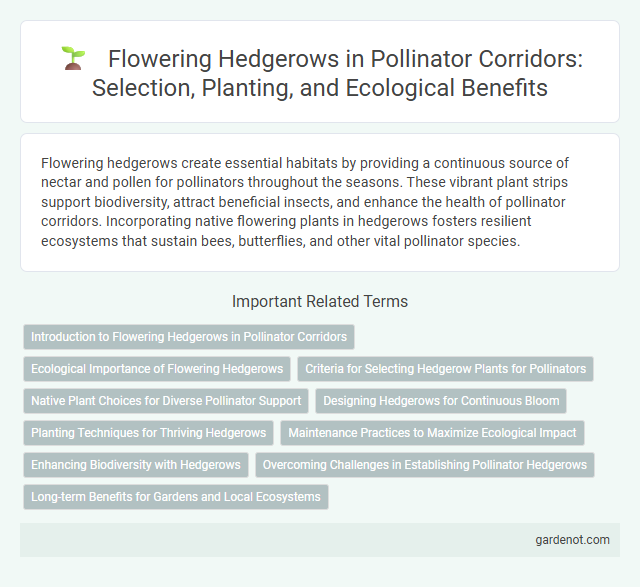Flowering hedgerows create essential habitats by providing a continuous source of nectar and pollen for pollinators throughout the seasons. These vibrant plant strips support biodiversity, attract beneficial insects, and enhance the health of pollinator corridors. Incorporating native flowering plants in hedgerows fosters resilient ecosystems that sustain bees, butterflies, and other vital pollinator species.
Introduction to Flowering Hedgerows in Pollinator Corridors
Flowering hedgerows in pollinator corridors serve as essential habitats by providing nectar and pollen sources that support diverse pollinator species, including bees, butterflies, and hoverflies. These linear planting arrangements increase landscape connectivity, facilitating pollinator movement between fragmented habitats and enhancing biodiversity. By incorporating native flowering plants with staggered bloom periods, flowering hedgerows ensure continuous resource availability throughout the growing season.
Ecological Importance of Flowering Hedgerows
Flowering hedgerows serve as vital pollinator corridors by providing continuous sources of nectar and pollen that support diverse pollinator species, including bees, butterflies, and hoverflies. They enhance habitat connectivity, enabling the safe movement and genetic exchange of pollinators across fragmented landscapes. These ecological benefits contribute to improved crop pollination, increased biodiversity, and the resilience of agroecosystems.
Criteria for Selecting Hedgerow Plants for Pollinators
Selecting hedgerow plants for pollinators requires prioritizing native species with staggered blooming periods to provide continuous nectar and pollen sources. Plants must support a diverse range of pollinators, including bees, butterflies, and hummingbirds, by offering various flower shapes, colors, and scents. Soil adaptability, pest resistance, and minimal maintenance needs are critical factors ensuring long-term sustainability and health of the pollinator corridor.
Native Plant Choices for Diverse Pollinator Support
Flowering hedgerows composed of native plants such as milkweed, goldenrod, and aster provide essential nectar and pollen for a wide range of pollinators, including bees, butterflies, and hummingbirds. These native species adapt well to local soil and climate conditions, promoting robust growth and continuous flowering throughout the growing season. Incorporating diverse native plants enhances habitat connectivity and supports pollinator health and biodiversity within the corridor.
Designing Hedgerows for Continuous Bloom
Designing hedgerows for continuous bloom involves selecting a diverse mix of native flowering plants that stagger their peak flowering periods from early spring to late fall. Incorporating species such as Black-eyed Susan (Rudbeckia hirta), Purple Coneflower (Echinacea purpurea), and Wild Bergamot (Monarda fistulosa) ensures sustained nectar and pollen availability for pollinators throughout the growing season. Strategic layering of shrubs, perennials, and grasses enhances habitat complexity while maintaining consistent floral resources in the pollinator corridor.
Planting Techniques for Thriving Hedgerows
Planting techniques for thriving flowering hedgerows emphasize selecting native, pollinator-friendly species arranged in staggered layers to maximize bloom duration and habitat complexity. Incorporating diverse plant heights and densities supports a wide range of pollinators while promoting soil health and erosion control. Proper spacing and regular maintenance, such as pruning and mulching, ensure robust growth and continuous floral resources along pollinator corridors.
Maintenance Practices to Maximize Ecological Impact
Regular pruning and selective trimming of flowering hedgerows promote vigorous growth and prolonged blooming periods, essential for sustaining pollinator populations. Incorporating native plant species and avoiding pesticides strengthens ecological resilience and provides continuous nectar and pollen sources. Seasonal mulching and targeted irrigation support plant health and soil quality, enhancing the corridor's overall biodiversity and habitat value.
Enhancing Biodiversity with Hedgerows
Flowering hedgerows serve as vital pollinator corridors by providing continuous sources of nectar and pollen, supporting diverse insect populations including bees, butterflies, and hoverflies. Their structural diversity offers shelter and breeding habitats, enhancing overall ecosystem resilience and promoting a balanced food web. Incorporating native flowering species tailored to local climates amplifies biodiversity benefits and sustains long-term pollinator health.
Overcoming Challenges in Establishing Pollinator Hedgerows
Establishing flowering hedgerows as pollinator corridors involves overcoming challenges such as selecting native plant species that bloom sequentially to provide continuous forage throughout the growing season. Soil preparation and moisture management are critical to ensuring plant establishment and long-term survival in varying environmental conditions. Effective maintenance practices including controlling invasive species and minimizing pesticide use enhance the hedgerow's biodiversity and its role in supporting pollinator populations.
Long-term Benefits for Gardens and Local Ecosystems
Flowering hedgerows create continuous habitats that support pollinator diversity by providing nectar and pollen throughout the growing season, enhancing garden productivity and plant health. These corridors facilitate pollinator movement and genetic exchange, promoting resilient local ecosystems and greater biodiversity. Over time, established hedgerows improve soil quality, reduce erosion, and contribute to natural pest control, offering sustainable advantages for both gardens and surrounding environments.
Flowering hedgerow Infographic

 gardenot.com
gardenot.com